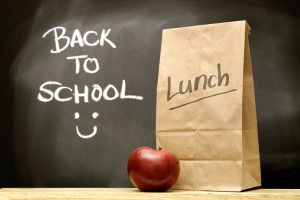 The start of the school year is a time for planning and preparation…the drop-off and pick-up schedule, after school child care (if you work), and back-to-school shopping. This year, don’t forget to add meal planning to that list. It’s easy to send your kids off with new clothes, notebooks, pens, etc….but they need good nutrition to be adequately prepared for the daily demands of school.
The start of the school year is a time for planning and preparation…the drop-off and pick-up schedule, after school child care (if you work), and back-to-school shopping. This year, don’t forget to add meal planning to that list. It’s easy to send your kids off with new clothes, notebooks, pens, etc….but they need good nutrition to be adequately prepared for the daily demands of school.
When I was a graduate student (San Jose State University), I spent time assessing the implementation of wellness policies on different San Jose school campuses. According to faculty and my observations, the most popular food item was Hot Cheetos, and that included breakfast! Often parents had sent their kids to school on a bag of chips. I know that convenience can be a big factor when it comes to food choices, especially when you’re scrambling out the door, but let’s arm our kids with better nutrition than that.
What difference does it make? A lot. Adequate nutrition can impact a child’s ability to focus and learn while at school. If you’ve ever been hungry and trying to concentrate, you can relate! I have tons of dieters who come to meet with me that are irritable and having a hard time focusing – once adequate nutrition has been implemented, those clients are able to think again. The same can be said for kids. In fact, the School Breakfast Program was introduced by the government due to the recognition that children need food and nutrients to learn. You can read more about it here: http://frac.org/federal-foodnutrition-programs/school-breakfast-program/.
When starting with breakfast and lunch planning, you can simplify the approach by aiming for 4 food groups per meal. Yes, the basic food groups of grains, protein/meat, fruit, vegetables and dairy. (Don’t forget the dairy – remember that your kids are building their bone density at this time, meaning calcium intake is extremely important!) For example: a whole wheat English muffin (grain), with a slice of cheese (dairy), an egg (protein – can be scrambled, fried, hard-boiled…however your child likes it!) and a banana on the side. For lunch, maybe a whole wheat tortilla (grain), filled with turkey (protein) and veggies (whatever your child likes and will eat) with a carton of milk (dairy). You can even get “fancy” with spreads like hummus or guacamole to add flavor and nutritional value.
Time Constraints
I know there is a time factor involved. I hear you. So here are some tips and ideas to getting a meal put together if time is your main barrier:
- Prepare some freezer meal options in advance such as making a large batch of breakfast burritos. They can be individually wrapped and broiled in the morning. Or make a large batch of whole grain waffles that can be frozen and toasted for breakfast.
- Make a smoothie – use chopped/frozen fruit, yogurt and possibly peanut butter or another nut butter. You can even freeze individual serving sizes of yogurt in ice cube trays and pop them into the blender.
- Have healthy, convenient options available in the home such as bars and frozen meals. Try to pick items that have at least 3 g. of dietary fiber, 500 mg. or less sodium, and under 10 g. of sugar.
- Create your own trail mix bags with nuts, dried fruit (with no added sugars) and a whole grain cereal.
- Purchase containers with different compartments in them for each different food group. Lunches don’t need to be fancy, it can be as simple as a combination of whole grain crackers, lunch meat, cheese, fruit and a carton of milk obtained at school.
- Buy a vegetable or fruit tray and create personalized baggies of vegetables or fruit for school days. They can all be prepared for the week ahead of time….and then you simply grab and go!
The extra few minutes of preparation the night before or morning of a school day can really make an impact in your child’s day!
For additional ideas, visit http://www.eatright.org/resources/for-kids/.